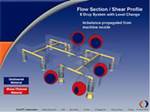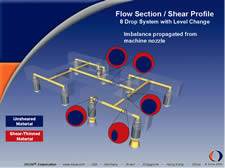Reduce Part Failure with Melt Delivery Science
The best way to determine when naturally balanced, rheological managed and thermally balanced hot runner solutions are required as a single solution is to examine the science behind each approach.
The best way to determine when naturally balanced, rheological managed and thermally balanced hot runner solutions are required as a single solution is to examine the science behind each approach.
Naturally balanced hot runner systems are used in multi-cavity mold applications where all the parts are the same. They are designed with equidistant flow paths and flow diameters held to tolerance. These applications allow for the use of manifolds with multi-level flow paths to achieve equal flow lengths to each of the cavities or the use of a bridge manifold.
Rheological managed hot runner systems are based on the flow of matter from which the Hagen–Poiseuille equation was developed. Still used today to calculate deltas in pressure drop for non-Newtonian fluids such as plastic, this equation has been recognized as essential to achieving true cavity-fill management by mapping dynamic viscosity variations as the plastic flows from the machine barrel into a hot runner system and then into the part. Mapping the distribution of the relative high and low plastic laminates and then managing those laminates so they are homogenously delivered to the cavity is crucial to the success of some applications.
Thermally balanced hot runner systems are designed to be thermally stable and homogenous throughout the manifolds and nozzles. This stability is easy to achieve when a system is sitting on a test bench, thermally isolated from surface contact that will influence heat distribution, but it is not so easy when the system is within a mold and in contact with various surfaces and cooling elements. Finite element analysis (FEA) and the right temperature controllers can be used to help meet this goal.
To illustrate the successful use of these three applied sciences as an all-in-one solution, let’s look at a specific 32-cavity, direct-valve-gated, preform mold application. The mold builder could not understand why the medical preform OEM/molder took “perfectly fine” molds and retrofitted the existing hot runner systems. To the mold builder’s knowledge, the molds performed well, but short-shot analysis proved otherwise. In addition, the delta in part fill directly corresponded to the fracturing failure of the bottles in the blow molding process.
The failure rate the molder was experiencing was considered “acceptable” until a deeper study of the fill patterns in relation to the fracture during the blow molding process proved that there was a direct correlation between bottle failure and preform filling patterns.
The existing molds used hot runner systems with naturally balanced and thermally balanced manifolds, but application of melt management science was missing. After the molder was introduced to rheological imbalances and the scientific approach to melt management, an investment in a mold using all three runner system approaches was made, and the results were favorable. This change yielded a substantial decrease in part-to-part weight variance and improved fill pattern in all stages of progressive short-shots. This, in turn, led to a reduction in part failure during the blow molding process, a six-figure material savings in the first year, faster mold startups and a more open process window.
Related Content
Plastic Prototypes Using Silicone Rubber Molds
How-to, step-by-step instructions that take you from making the master pattern to making the mold and casting the plastic parts.
Read More6 Ways to Optimize High-Feed Milling
High-feed milling can significantly outweigh potential reliability challenges. Consider these six strategies in order to make high-feed milling successful for your business.
Read MoreThe Benefits of Hand Scraping
Accuracy and flatness are two benefits of hand scraping that help improve machine loop stiffness, workpiece surface finish and component geometry.
Read MoreTreatment and Disposal of Used Metalworking Fluids
With greater emphasis on fluid longevity and fluid recycling, it is important to remember that water-based metalworking fluids are “consumable” and have a finite life.
Read MoreRead Next
Improving Shear-Induced Imbalance in Hot Runner Systems
Even melt distribution and balanced filling to and across all cavities while avoiding restrictive mixers is possible with hot runner manifold construction that incorporates a melt rotation design.
Read MoreHow to Use Strategic Planning Tools, Data to Manage the Human Side of Business
Q&A with Marion Wells, MMT EAB member and founder of Human Asset Management.
Read MoreAre You a Moldmaker Considering 3D Printing? Consider the 3D Printing Workshop at NPE2024
Presentations will cover 3D printing for mold tooling, material innovation, product development, bridge production and full-scale, high-volume additive manufacturing.
Read More











.png;maxWidth=300;quality=90)













